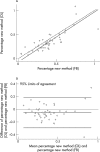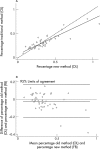Intraepithelial lymphocytes in the villous tip: do they indicate potential coeliac disease?
- PMID: 15280404
- PMCID: PMC1770380
- DOI: 10.1136/jcp.2003.013607
Intraepithelial lymphocytes in the villous tip: do they indicate potential coeliac disease?
Abstract
Background: The counting of intraepithelial lymphocytes (IELs) in the villous tips of architecturally normal small bowel biopsy specimens was proposed as a method to measure mucosal infiltration in gluten sensitive patients.
Aims: To apply this straightforward method in duodenal biopsy specimens from patients affected by potential coeliac disease (PCD) to verify whether it can discriminate these patients from controls.
Methods: Paraffin wax embedded duodenal sections from 11 patients affected by PCD were stained with an antihuman CD3 antibody. Sections from 19 patients affected by treated coeliac disease (TCD) and 17 patients in whom coeliac disease was excluded were stained with the same antibody to serve as controls. The slides were examined blindly. IELs/20 enterocytes in five randomly chosen villous tips were counted. Patients affected by PCD were all on a gluten containing diet. They had an architecturally normal duodenal mucosa and were positive for endomysial antibody. Both TCD and non-coeliac controls were negative for endomysial antibody.
Results: The mean villous tip IEL scores were 4.6 (SD, 1.5; range, 1.4-7.8) in non-coeliac controls, 7.9 (SD, 4.0; range, 2.0-18.6) in TCD, and 9.2 (SD, 4.7; range, 5.8-21.8) in patients with PCD. The difference between PCD and non-coeliac controls was significant.
Conclusions: This is a very simple and sufficiently reliable method to count IELs. In patients with an architecturally normal duodenal mucosa, the IEL count in villous tips helps to distinguish between patients with PCD and non-coeliac controls.
Figures




Similar articles
-
Is a raised intraepithelial lymphocyte count with normal duodenal villous architecture clinically relevant?J Clin Pathol. 2002 Jun;55(6):424-8. doi: 10.1136/jcp.55.6.424. J Clin Pathol. 2002. PMID: 12037023 Free PMC article.
-
The occurrence of terminal ileal histological abnormalities in patients with coeliac disease.Dig Liver Dis. 2006 Nov;38(11):815-9. doi: 10.1016/j.dld.2006.04.003. Epub 2006 Jun 19. Dig Liver Dis. 2006. PMID: 16787773
-
Histology of the terminal ileum in coeliac disease.Scand J Gastroenterol. 2004 Jul;39(7):665-7. doi: 10.1080/00365520410004901. Scand J Gastroenterol. 2004. PMID: 15370688
-
Pathological and clinical significance of increased intraepithelial lymphocytes (IELs) in small bowel mucosa.APMIS. 2005 Jun;113(6):385-99. doi: 10.1111/j.1600-0463.2005.apm_204.x. APMIS. 2005. PMID: 15996156 Review.
-
An update in the diagnosis of coeliac disease.Histopathology. 2011 Aug;59(2):166-79. doi: 10.1111/j.1365-2559.2010.03680.x. Epub 2010 Nov 3. Histopathology. 2011. PMID: 21054494 Review.
Cited by
-
Discriminant value of IEL counts and distribution pattern through the spectrum of gluten sensitivity: a simple diagnostic approach.Virchows Arch. 2018 Nov;473(5):551-558. doi: 10.1007/s00428-018-2430-1. Epub 2018 Aug 9. Virchows Arch. 2018. PMID: 30094491
-
Morphologic Spectrum of Duodenal Biopsies in Malabsorption: A Study from Southern India.J Clin Diagn Res. 2017 Jul;11(7):EC17-EC21. doi: 10.7860/JCDR/2017/23871.10231. Epub 2017 Jul 1. J Clin Diagn Res. 2017. PMID: 28892904 Free PMC article.
-
Evolutionary Developments in Interpreting the Gluten-Induced Mucosal Celiac Lesion: An Archimedian Heuristic.Nutrients. 2017 Feb 28;9(3):213. doi: 10.3390/nu9030213. Nutrients. 2017. PMID: 28264483 Free PMC article. Review.
-
ROC-king onwards: intraepithelial lymphocyte counts, distribution & role in coeliac disease mucosal interpretation.Gut. 2017 Dec;66(12):2080-2086. doi: 10.1136/gutjnl-2017-314297. Epub 2017 Sep 11. Gut. 2017. PMID: 28893865 Free PMC article.
-
The absence of a mucosal lesion on standard histological examination does not exclude diagnosis of celiac disease.Dig Dis Sci. 2008 Jan;53(1):52-61. doi: 10.1007/s10620-007-9821-5. Epub 2007 May 9. Dig Dis Sci. 2008. PMID: 17487584
References
-
- Trier JS. Celiac sprue and refractory sprue. In: Feldman M, Scharschmidt BF, Sleisenger MH, eds. Sleisenger and Fordtran’s gastrointestinal and liver disease. 6th ed. Philadelphia: WB Saunders, 1997:1557–73. - PubMed
-
- Biagi F, Corazza GR. Clinical features of coeliac disease. Dig Liver Dis 2002;34:225–8. - PubMed
-
- Marsh MN, Crowe PT. Morphology of the mucosal lesion in gluten sensitivity. Baillieres Clin Gastroenterol 1995;9:273–93. - PubMed
MeSH terms
Substances
LinkOut - more resources
Full Text Sources
Medical
